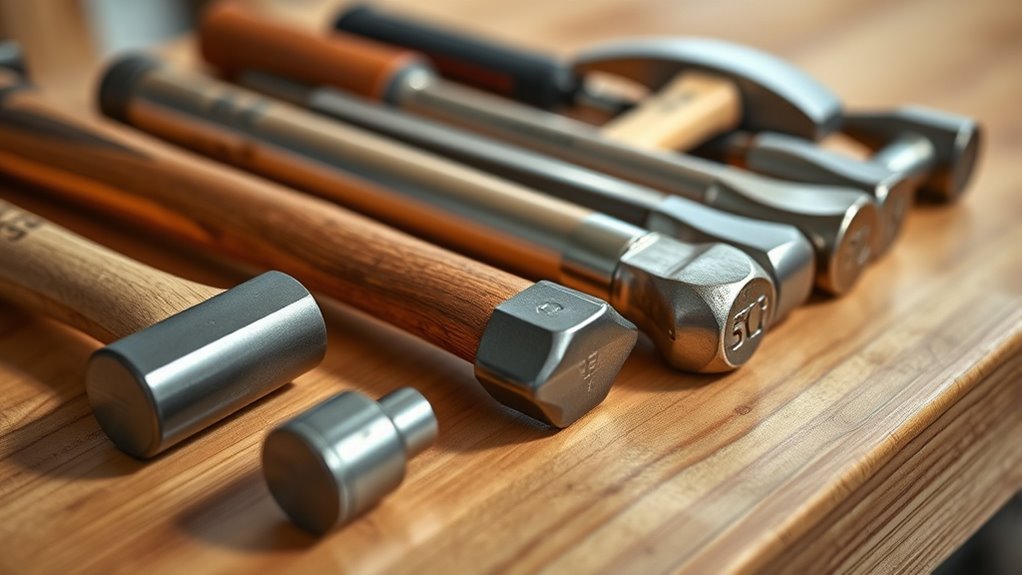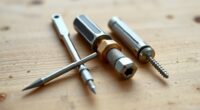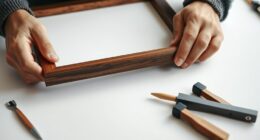To select the right hammer, consider the project type and pick a suitable head shape, like a claw for carpentry or a sledge for demolition. Choose a weight that matches your comfort and task complexity—lighter for precision, heavier for tough jobs. Pay attention to handle materials and grip styles for comfort and safety, and make certain the tool has proper safety features. Want to learn more about matching hammers to your needs? Keep exploring!
Key Takeaways
- Match the hammer head shape and size to your specific task, such as framing, finishing, or metalworking.
- Choose a handle material and grip style that offers comfort, control, and reduces fatigue during extended use.
- Select the appropriate weight—lighter for precision work, heavier for demolition or framing tasks.
- Ensure the hammer’s construction is durable, with a secure attachment between handle and head for safety.
- Incorporate safety features like shock-absorbing grips and inspect the tool regularly for damage to maintain safety.
Types of Hammers and Their Uses
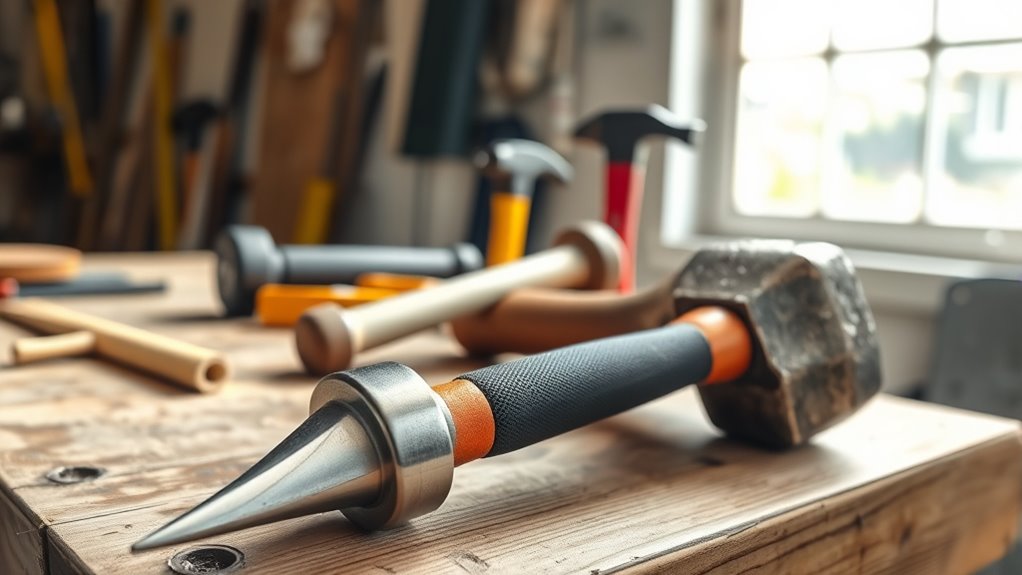
When choosing a hammer, understanding the different types and their specific uses is vital. Hammer grip styles vary, influencing comfort and control—whether you prefer a firm, power grip or a lighter, precision grip. The hammer head shape also matters; for example, a claw hammer features a curved head for pulling nails, while a sledgehammer has a broad, heavy head for demolition work. Claw hammers are versatile for carpentry, whereas ball-peen hammers suit metalworking. The design of the hammer head helps determine its purpose, making it essential to select the right shape for your task. Matching grip styles and head shapes ensures efficiency, safety, and comfort, helping you work effectively and avoid fatigue or injury. Additionally, understanding home improvement principles can help you choose the most appropriate tool for your project.
Materials and Construction of Hammers
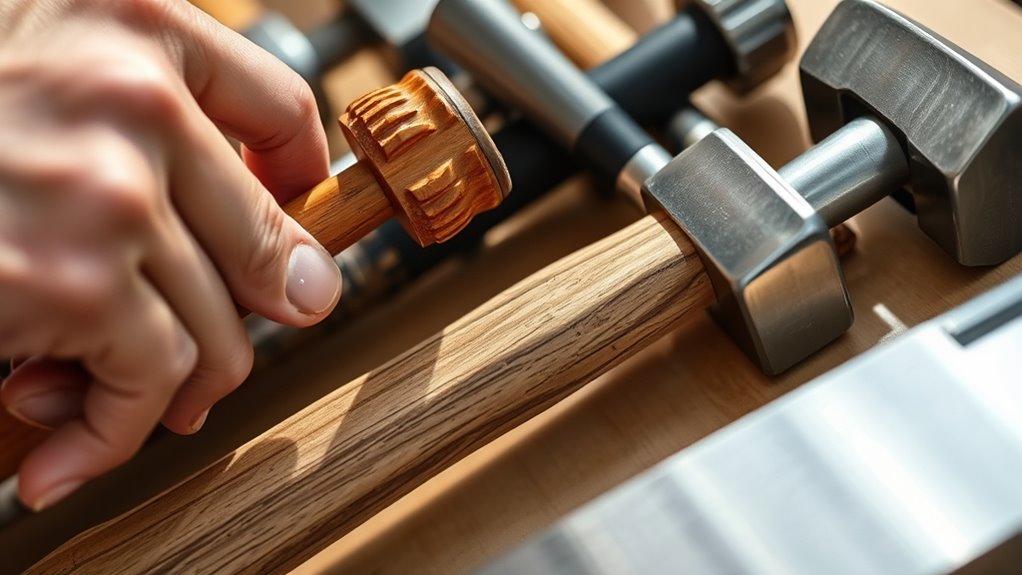
The materials and construction of a hammer directly impact its durability, weight, and performance. The hammer head materials are crucial; steel is common for strength, while fiberglass or composite heads offer shock absorption. Wood handles provide traditional comfort, but many prefer fiberglass or reinforced handles for added durability. Handle ergonomics play a vital role in reducing fatigue and improving control, so look for designs that fit comfortably in your hand. The way the handle attaches to the head also affects overall strength and safety. A well-constructed hammer balances the head and handle, ensuring efficient force transfer and minimizing wobble or breakage. Choosing a hammer built with quality materials and ergonomic design ensures it will last longer and perform better during your projects. Additionally, understanding the specific material properties can help you select the right hammer for different tasks and environments.
Weight and Size Considerations

Choosing the right weight and size for your hammer depends on the tasks you’ll perform and your physical comfort. A properly sized hammer improves efficiency and reduces fatigue. Consider these key points:
- Select a lighter hammer, around 16 ounces, for delicate tasks and precise control.
- Use a heavier hammer, 20-28 ounces, for framing or demolition work, ensuring it has an ergonomic grip to reduce strain.
- Think about storage options—compact hammers fit in small spaces, while larger ones may require dedicated tool storage.
- The weight classification of a hammer influences its suitability for different projects and user comfort.
Matching the hammer’s weight to your task and comfort level helps prevent injury and fatigue. An ergonomic grip ensures better handling, and choosing the right size makes storage easier, keeping your workspace organized and efficient.
Handle Types and Comfort
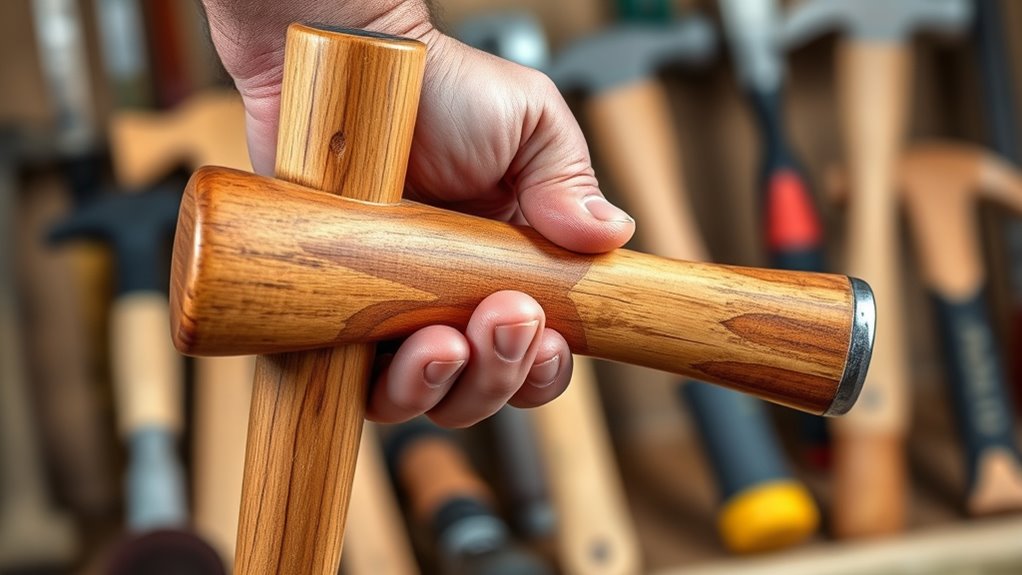
Selecting a hammer with the right handle type can substantially enhance your comfort and control during use. Ergonomic grips are designed to fit comfortably in your hand, reducing fatigue and improving precision. Look for handles made from durable materials like fiberglass or reinforced steel, which offer excellent handle durability and resist cracking or splintering over time. Rubber or cushioned grips can absorb shock, making extended use less tiring. Consider the shape of the handle—some are curved for better leverage, while others are straight for accuracy. A well-designed handle minimizes slipping and ensures a secure grip, which is essential for safety and efficiency. Ultimately, choosing a handle that balances comfort with durability helps you work longer and more effectively. Additionally, paying attention to handle design can further optimize your work experience by providing better ergonomics.
Safety Features and Maintenance
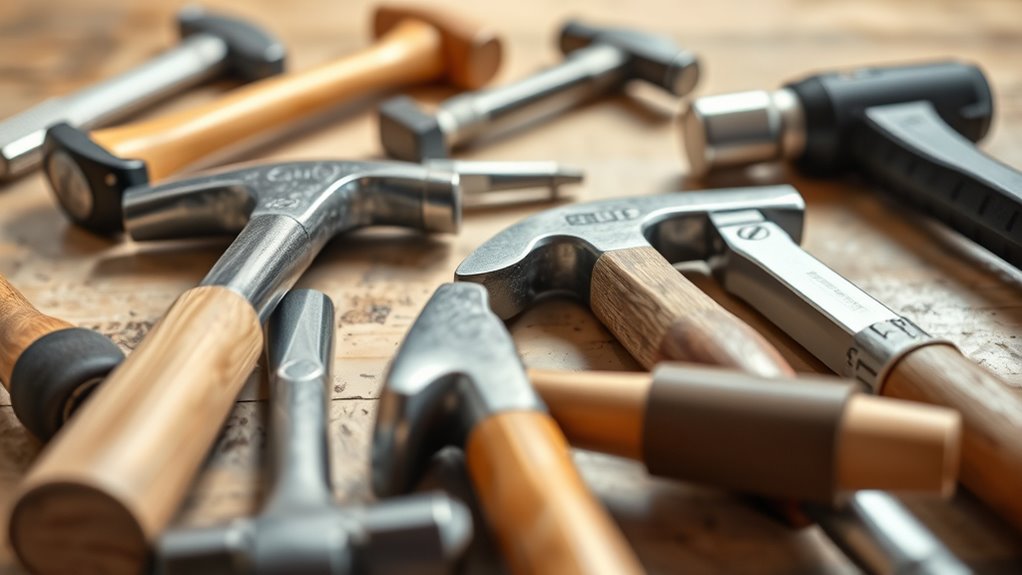
Ensuring your hammer is equipped with proper safety features and maintaining it regularly can prevent accidents and extend its lifespan. Start by checking for an ergonomic grip to reduce hand fatigue and improve control. Always wear appropriate safety gear, like safety glasses and gloves, to protect against flying debris and accidental slips. Keep your hammer in good condition by inspecting the head for cracks or looseness, cleaning the handle, and storing it properly. Additionally, understanding safety features can help you select tools that offer enhanced protection during use.
Frequently Asked Questions
How Do I Determine the Best Hammer for DIY Projects?
When selecting the best hammer for your DIY projects, consider the different hammer types suited for various tasks, like claw, ball-peen, or sledgehammers. You should also prioritize grip comfort to reduce fatigue and improve control. Think about the project’s requirements and choose a hammer that fits comfortably in your hand, feels balanced, and is appropriate for the materials you’ll work with. This guarantees efficiency and safety in your DIY endeavors.
Can I Use the Same Hammer for Metal and Woodwork?
You can’t use the same hammer for metal and woodwork safely. Metalwork requires a hammer with a different weight and head design, and using the wrong one can compromise hammer safety. Opt for a hammer with an ergonomic hammer design to reduce fatigue and injury. Always select the right tool for the task, and guarantee your hammer has a comfortable grip to maintain control and safety during use.
What Is the Ideal Price Range for a Quality Hammer?
When you’re looking for a quality hammer, your ideal price range depends on your needs. Budget options can be found for around $20 to $50, offering decent performance for light tasks. If you want premium tools with durability and precision, expect to spend $60 to $150 or more. Invest wisely based on your project scope, and remember, sometimes paying a bit more guarantees better quality and longevity.
How Do I Choose a Hammer for Delicate or Precision Work?
Think of your hand as a conductor, guiding a delicate symphony. For precision work, choose a hammer with a lightweight, well-balanced handle made of comfortable material like wood or fiberglass. The hammer head should be small and smooth, minimizing damage. Feel the handle’s grip, ensuring it’s firm yet gentle. This harmony between hammer head and handle material helps you work with finesse, turning every strike into art.
Are There Eco-Friendly or Sustainable Hammer Options Available?
You might be glad to know eco-friendly hammers are available. Look for options made from recycled materials, which reduce waste and environmental impact. Some brands also offer biodegradable coatings on the handles or head, making the tool easier to recycle or compost after its long life. By choosing these sustainable options, you can work effectively and help protect the environment at the same time.
Conclusion
Choosing the right hammer is like selecting the perfect brush for a masterpiece—you shape your work with precision and confidence. By understanding the different types, materials, and features, you become the artist of your craft. When you pick a hammer that fits comfortably and suits your needs, you wield the brush with ease, transforming raw materials into something extraordinary. Remember, the right tool elevates your work from mere effort to true craftsmanship.
